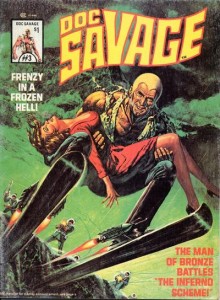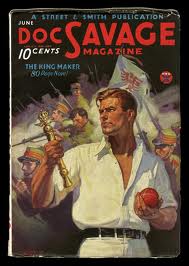Doc Savage
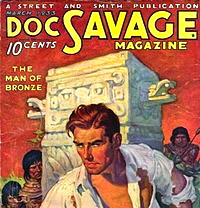
Doc Savage: The Important Parts
 Doc Savage Magazine #1 (March 1933).
Doc Savage Magazine #1 (March 1933).
Doc Savage is a fictional character originally published in American pulp magazines during the 1930s and 1940s. He was created by publisher Henry W. Ralston and editor John L. Nanovic at Street and Smith Publications, with additional material contributed by the series’ main writer, Lester Dent.
The heroic-adventure character would go on to appear in other media, including radio,film, and comic books, with his adventures reprinted for modern-day audiences in series of paperback books. Into the 21st century, Doc Savage has remained a nostalgic icon in the U.S., referenced in novels and in popular culture.
Overview
The Doc Savage Magazine was printed by Street and Smith Publications from March 1933 to the summer of 1949. In all, 181 issues were published.
Doc Savage became known to more contemporary readers when Bantam Books began reprinting the individual magazine novels in 1964, this time with covers by artist James Bama that featured a bronze-haired, bronze-skinned Doc Savage with an exaggerated widows’ peak, usually wearing a torn khaki shirt and under the by-line “Kenneth Robeson”. The stories were not reprinted in chronological order as originally published, though they did begin with the first adventure, The Man of Bronze. By 1967, Bantam was publishing one a month until 1990, when all 181 original stories (plus an unpublished novel, The Red Spider) had run their course. AuthorWill Murray produced seven more Doc Savage novels for Bantam Books from Lester Dent’s original outlines. Bantam also published a novel by Philip José Farmer, Escape From Loki (1991), which told the story of how Doc in World War I met the men who would become his five comrades.
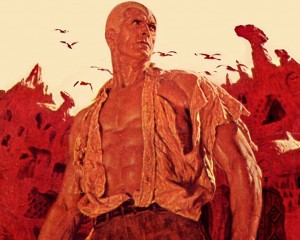 Clark Savage, Jr., first appeared in March 1933 in the first issue of Doc Savage Magazine. Because of the success of the Shadow, who had his own pulp magazine, the publishers Street & Smith quickly launched this pulp title. Unlike the Shadow, Clark Savage (or “Doc” to his friends), had no special powers, but was raised from birth by his father and other scientists to become one of the most perfect human beings in terms of strength, mental and physical agilities.
Clark Savage, Jr., first appeared in March 1933 in the first issue of Doc Savage Magazine. Because of the success of the Shadow, who had his own pulp magazine, the publishers Street & Smith quickly launched this pulp title. Unlike the Shadow, Clark Savage (or “Doc” to his friends), had no special powers, but was raised from birth by his father and other scientists to become one of the most perfect human beings in terms of strength, mental and physical agilities.
Doc Savage set up base on the 86th floor of a world famous New York skyscraper (implied, but never outright stated, as the Empire State Building; although Phillip Jose Farmer, in his Doc Savage: His Apocalyptic Life, gives good evidence that this is more likely so). Doc Savage fights against evil with the assistance of the “fabulous five”.
Comics, movies, pulp magazines
Doc Savage has appeared in comics and a movie, on radio, and as a character in numerous other works, and continues to inspire authors and artists in the realm of fantastic adventure.
Doc Savage Magazine was created by Street & Smith Publications executive Henry Ralston and editor John Nanovic to capitalize on the success of Street and Smith’s pulp character, the Shadow. Ralston and Nanovic wrote a short premise establishing the broad outlines of the character they envisioned, but Doc Savage was only fully realized by the author chosen to write the series, Lester Dent. Dent wrote most of the 181 original novels, hidden behind the “house name” of Kenneth Robeson.
One Lester Dent biographer hypothesizes that one inspiration for Doc Savage may have been the American military officer and authorRichard Henry Savage, who wrote more than 40 books of adventure and mystery stories and lived a dashing and daring life.
Doc Savage may have also been influenced by Philip Wylie‘s 1932 novel, The Savage Gentleman, in which a man spirits his son off to a secret island where he raises him as the perfect gentleman and trains him as an ideal physical specimen, but with no understanding of women, much like Doc Savage.
Doc Savage’s real name was Clark Savage, Jr. He was a physician, surgeon, scientist, adventurer, inventor, explorer, researcher, and, as revealed in The Polar Treasure, a musician. A team of scientists assembled by his father deliberately trained his mind and body to near-superhuman abilities almost from birth, giving him great strength and endurance, a photographic memory, a mastery of the martial arts, and vast knowledge of the sciences. Doc is also a master of disguise and an excellent imitator of voices. “He rights wrongs and punishes evildoers.” Dent described the hero as a mix of Sherlock Holmes‘ deductive abilities, Tarzan‘s outstanding physical abilities,Craig Kennedy‘s scientific education, and Abraham Lincoln‘s goodness. Dent described Doc Savage as manifesting “Christliness.” Doc’s character and world-view is displayed in his oath, which goes as follows:
Let me strive every moment of my life to make myself better and better, to the best of my ability, that all may profit by it. Let me think of the right and lend all my assistance to those who need it, with no regard for anything but justice. Let me take what comes with a smile, without loss of courage. Let me be considerate of my country, of my fellow citizens and my associates in everything I say and do. Let me do right to all, and wrong no man.
The 86th Floor
His office is on the 86th floor of a New York City skyscraper, implicitly the Empire State Building, reached by Doc’s private high-speed elevator. Doc owns a fleet of cars, trucks, aircraft, and boats which he stores at a secret hangar on the Hudson River, under the nameThe Hidalgo Trading Company, which is linked to his office by a pneumatic-tube system nicknamed the “flea run.” He sometimes retreats to his Fortress of Solitude in the Arctic — which pre-dates Superman‘s similar hideout of the same name. All of this is paid for with gold from a Central American mine given to him by the local descendants of the Mayans in the first Doc Savage story. (Doc and his assistants learned the little-known Mayan language of this people, allowing them to communicate privately when others might be listening.)
Savage is accompanied on his adventures by up to five other regular characters (referred to in the 1975 movie and in marketing materials from the Bantam Books republication as “The Fabulous Five”), all highly accomplished individuals in their own right.
- Lieutenant Colonel Andrew Blodgett “Monk” Mayfair, an industrial chemist. Monk got his nickname from his simian build, notably his long arms, and his covering of red hair. He is in a constant state of “friendly feuding” with “Ham” Brooks. This began when his friend taught him some French words to say to an officer and Monk repeated them, not knowing they were a string of insults. The result was a lengthy stay in the guardhouse.
- Brigadier General Theodore Marley “Ham” Brooks, an accomplished attorney. Ham was considered one of the best-dressed men in the world, and as part of his attire, carried a sword cane whose blade is dipped in a fast-acting anesthetic. His nickname was acquired when Monk, in retaliation for his guardhouse incarceration, framed Brooks on a charge of stealing hams from the commissary. In the only case which Ham ever lost, he was convicted of stealing the hams.
- Colonel John “Renny” Renwick, a construction engineer. Renny was a giant of a man, with “fists like buckets of gristle and bone.” His favorite pastime was knocking the panels out of heavy wooden doors. He always wore a look of depression, which deepened the happier he grew.
- Major Thomas J. “Long Tom” Roberts, an electrical engineer. “Long Tom” got his nickname from using an antiquated cannon of that nickname in the successful defense of a French village in World War I. Long Tom was a sickly-looking character, but fought like a wildcat.
- William Harper “Johnny” Littlejohn, an archaeologist and geologist. Johnny had an impressive vocabulary, never using a small word when a big one could suffice. (“I’ll be superamalgamated!” was a favorite expression). Johnny wore eyeglasses with a magnifying lens over his left eye in early adventures (that eye having been damaged in World War I). Doc later performed corrective surgery that restored Johnny’s sight in that eye, but Johnny retained the magnifier as a monocle for use both as a magnifying glass and as a memento.
In later stories, Doc’s companions became less important to the plot as the stories focused more on Doc himself. At least one critic questioned their necessity since Savage’s talents were superior to theirs and he often had to rescue them. The “missing” characters were explained as working elsewhere, too busy with their own accomplishments to help. Toward the end of the series, usually only Monk and Ham appeared with Doc.
Doc’s cousin Patricia “Pat” Savage, who has Doc’s bronze skin, golden eyes, and bronze hair, also was along for many of the adventures, despite Doc’s best efforts to keep her away from danger. Pat chafes under these restrictions, or indeed any effort to protect her simply because she is female. She is also able to fluster Doc, even as she completely charms Monk and Ham.
Doc’s greatest foe, and the only enemy to appear in two of the original pulp stories, was the Russian-born John Sunlight, introduced in October 1938 in the Fortress of Solitude. Early villains in the “super-sagas” were fantastic schemers bent on ruling the world. Later the magazine was retitled Doc Savage, Science Detective, with a more realistic detective feel where Doc broke up crime rings. With a new editor, the last three magazines returned to the super-saga, then was canceled, as were most other pulp magazines.
A keynote of Doc’s adventures is that no matter how fantastic the monster or menace, there was usually a rational scientific explanation at the end. A giant mountain-walking spider was revealed as a blimp, a scorching death came from super-charged electric batteries, a “sea angel” was a mechanical construct towed behind a submarine, Navy ships sunk by a mysterious compelling force were actually sabotaged, and so on. But Doc Savage also battled invisible killers, a murderous teleporter, and superscientific foes from the center of the Earth.
In early stories some of the criminals captured by Doc received “a delicate brain operation” to cure their criminal tendencies. The criminals returned to society fully productive and unaware of their criminal past. It is referred to in Truman Capote‘s book, In Cold Blood, as an older Kansan recalls Doc’s “fixing” criminals he had caught.
Gadgets
Some of the gadgets described in the series became reality, including flying wing, answering machines, television, automatic transmission, night vision goggles, electromagnetic rail guns, and hand-held automatic weapons called variously machine pistol, supermachine pistol or rapid-firer. Doc has created a wide range of ammunition types for the machine pistols including incendiary bullets that smash on contact, coating the target with a high-temp paste-fed fire, high explosive bullets able to uproot trees, ordinary lead bullets & tracer, and the trademark sleep-inducing “mercy bullets” rather than regular lead bullets which are used in gunfights in keeping with Doc’s firm code against personal direct taking of human life, even of the most evil. (Doc has no problem with enemies dying from causes other than his direct attack on them, though).
Lester Dent
Lester Dent, the series’ principal author, had a mixed regard for his own creations. Though usually protective of his own work, he could be derisive of his pulp output. In interviews, he stated that he harbored no illusions of being a high-quality author of literature; for him, the Doc Savage series was simply a job, a way to earn a living by “churning out reams and reams of sellable crap”, never dreaming how his series would catch on. Comics historian Jim Steranko revealed that Dent used a formula to write his Doc Savage stories, so that his heroes were continually, and methodically, getting in and out of trouble. Dent was paid $750 per story during the Great Depression, and was able to buy a yacht and vacation in the Caribbean.
Publication history – List of Doc Savage novels
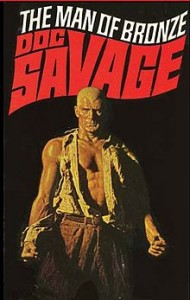 James Bama’s covers featuring Steve Holland as the Man of Bronze on many of the Bantam reprints defined the character to a generation of readers.
James Bama’s covers featuring Steve Holland as the Man of Bronze on many of the Bantam reprints defined the character to a generation of readers.
All of the original stories were reprinted in paperback form by Bantam Books in the 1960’s through 1990’s. Of the first 67 paperback covers, 62 were painted in extraordinary monochromatic tones and super-realistic detail by James Bama, whose updated vision of Doc Savage with the exaggerated widow’s peak captured, at least symbolically, the essence of the Doc Savage novels. The first 96 paperbacks reprinted one of the original novels per book. Actor and model Steve Holland who had played Flash Gordon in a 1953 television series was the model for Doc on all the covers. The next 15 paperbacks were “doubles,” reprinting two novels each (these were actually shorter novellas written during paper shortages of World War II). The last of the original novels were reprinted in a numbered series of 13 “omnibus” volumes of four to five stories each. It was one of the few pulp series to be completely reprinted in paperback form.
The Red Spider was a Doc Savage novel written by Dent in April 1948, about the Cold Warwith the Soviet Union. The story was killed in 1948 by new editor Daisy Bacon, though previous editor William de Grouchy had commissioned it. It was forgotten until 1975, when Doc Savage scholar Will Murray found hints of its existence in the Street & Smith archives. After a two-year search, the carbon manuscript was located among Dent’s papers. It finally saw print in July 1979 as Number 95 in Bantam’s Doc Savage series.
When the original pulp stories were exhausted, Bantam Books hired Phillip Jose Farmer to pen the tale of how Doc and his men met in World War I. Escape from Loki was published in 1991. It was followed by seven traditional Doc Savage stories written by novelist Will Murray, working from unpublished Lester Dent outlines, beginning with Python Isle. Philip José Farmer had earlier written the book ‘Doc Savage: His Apocalyptic Life (1973), which described the characters and the stories on the entertaining premise that Doc actually existed and the novels chronicled his exploits in ‘fictionized’ form.
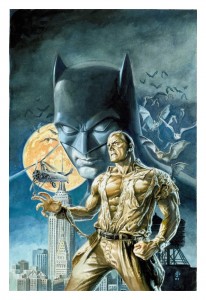 In 2011, Altus Press revived the series with another Murray-Dent posthumous collaboration, The Desert Demons. Eight new novels are planned for the new series The Wild Adventures of Doc Savage. In 2011, Doc Savage: Horror in Gold was published. In 2012 Altus Press published Doc Savage: Death’s Dark Domain, Doc Savage: The Forgotten Realm, Doc Savage: The Infernal Buddha and Doc Savage: The Desert Demons. Doc Savage: Skull Island was released in 2013.
In 2011, Altus Press revived the series with another Murray-Dent posthumous collaboration, The Desert Demons. Eight new novels are planned for the new series The Wild Adventures of Doc Savage. In 2011, Doc Savage: Horror in Gold was published. In 2012 Altus Press published Doc Savage: Death’s Dark Domain, Doc Savage: The Forgotten Realm, Doc Savage: The Infernal Buddha and Doc Savage: The Desert Demons. Doc Savage: Skull Island was released in 2013.
Sanctum Books, in association with Nostalgia Ventures, began a new series of Doc reprints (starting November 2006), featuring two novels per book, in magazine-sized paperbacks. Several editions came with a choice of the original pulp cover or the covers from the Bantam paperbacks, and most include the original interior artwork, as well as new essays and reprints of other old material. In late 2008, Nostalgia Ventures ended their relationship, and Sanctum Books continues with the reprints on their own.
Radio – List of Doc Savage radio episodes
Two Doc Savage radio series were broadcast during the pulp era. The first, in 1934, was a 15-minute serial which ran for 26 episodes. The 1943 series was based not on the pulps, but on the comic book version of the character. No audio exists from either series, although some scripts survived. In 1985, National Public Radio aired The Adventures of Doc Savage, as 13 half-hour episodes, based on the pulps and adapted by Will Murray and Roger Rittner. Daniel Chodos starred as Doc.
Comic books – Golden Age
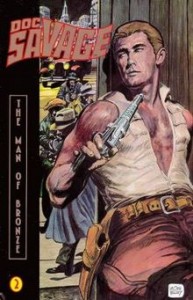 Doug Wildey’s cover for Millennium’sDoc Savage: The Man of Bronze.
Doug Wildey’s cover for Millennium’sDoc Savage: The Man of Bronze.
Street & Smith published comic book stories of Doc both in The Shadow comic and his own title. These started with Shadow Comics #1-3 (1940), then moved to Doc Savage Comics. Originally, these stories were based on the pulp version, but with Doc Savage Comics #5 (1941), he was turned into a genuine superhero when he crashed in Tibet and found a mystical gem in a hood. These stories had a Doc who bore little resemblance to the character in the pulps. This lasted through the end of Doc Savage Comics in 1943 after 20 issues, and briefly with his return to Shadow Comics in vol. 3, #10 (Jan. 1944). He would last until the final issue, vol. 9, #5 (1948), though did not appear in every one. He also appeared in Supersnipe Comics #9 (June 1943).
Modern Age – Post-Golden Age, there have been several Doc Savage comic books:
- Gold Key Comics, 1966, one issue adaptation of The Thousand-Headed Man to tie into the planned movie starring Chuck Connors. Doc resembles Connors on the cover.
- Marvel Comics. In 1972, eight standard color comics with four adaptations of books —The Man of Bronze, Brand of the Werewolf, Death in Silver, and The Monsters — and one giant-size issue of reprints that was promoted as a movie issue. In May 2010, DC Comics reprinted the eight-issue series as a trade paperback. In 1975, the Marvel imprintCurtis Magazines released eight black-and-white magazines as a movie tie-in. These were also collected by DC Comics and reprinted in July 2011 as a trade paperback. All are original stories by Doug Moench, John Buscema, and Tony DeZuniga. The character also teamed up with the Thing in Marvel Two-in-One #21, an important issue that would form the basis of later significant stories like “The Project Pegasus Saga” and “Squadron Supreme: Death of a Universe”.
- DC Comics, 1987–1990, a four-issue mini-series tryout, then 24 issues and one Annual, most written by Mike W. Barr. Original adventures, including a reunion with Doc’s Mayan sweetheart/wife Monya and John Sunlight, adventures with Doc’s grandson “Chip” Savage, and back story on Doc’s parents and youth. Included a four-issue crossover with DC’s current run of The Shadow.
- Millennium Publications published several mini-series and one-shots, including Doc Savage: The Monarch of Armageddon, a four-part limited series, from 1991 to 1992. Written by Mark Ellis and penciled by Darryl Banks, the treatment “come[s] closest to the original, capturing all the action, humanity, and humor of the original novels.” Other miniseries were Doom Dynasty and Devil’s Thoughts, and one-shots Pat Savage: Woman of Bronze and Manual of Bronze.
- Dark Horse Comics, 1995, two mini-series: a two-issue mini-series The Shadow and Doc Savage and four-issue Doc Savage: Curse of the Fire God.
- DC announced in 2009 that it would publish a Doc Savage crossover with Batman, written by Brian Azzarello with art by Phil Notoand a cover by J. G. Jones. Other characters involved will be Black Canary, The Avenger, Rima the Jungle Girl, the Spirit, and Doc Savage’s the Fabulous Five. It is a prologue to First Wave, a six-issue limited series with art by Rags Morales. The First Wave line was then expanded to include a Doc Savage ongoing series written by Paul Malmont, with art by Howard Porter. Malmont only wrote the first four issues, with other authors writing the rest of the series.
- In December 2013 Dynamite Entertainment began a reboot of the comic under the title Doc Savage: The Man of Bronze written by Chris Roberson, art by Bilquis Evely and covers by Alex Ross.

